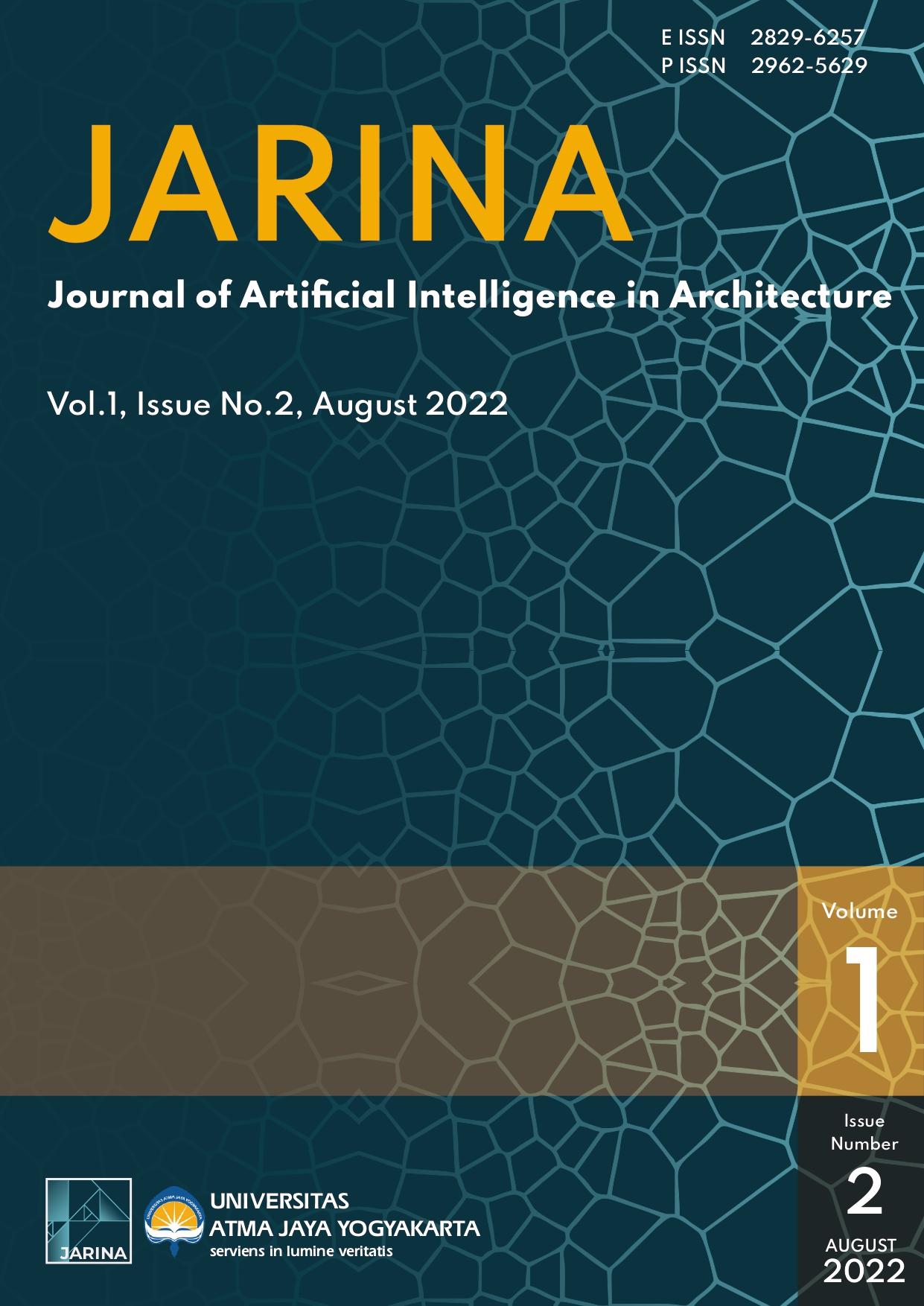Virtual Reality Application of Interactive Interior: The Development Study for Computer and Android Smartphones
DOI:
https://doi.org/10.24002/jarina.v1i2.6106Keywords:
Virtual Reality, Digital Environment, Interactive Interior, Unity3D, VR Application DevelopmentAbstract
This research describes the process, obstacles, and results in making a Virtual Reality Application of interactive interior using Unity 3D. In this research, we propose a VR application that supports interaction and VR views between users and the digital environment using computers and android smartphones. The study has three stages, namely input, process, and output. C# script was developed for user interaction with the digital environment. The user can interact in a small interior room with digital objects such as moving around, changing furniture color, and switching the light on or off. The research successfully created a virtual reality application using Unity3D for computers and android smartphones. This study clearly describes the step of making virtual reality applications and the problems encountered during the process—also, a more stabilized method for developing the interactive user feature. Moreover, the research brings another opportunity for VR application development that focuses on other VR development factors such as immersion, imagination, and insight.
References
J.-H. K. J.-H. Kim et al., “Virtual Reality History, Applications, Technology and Future,” Digit. Outcasts, vol. 63, no. ISlE, pp. 92–98, 2013, [Online]. Available: http://www.cg.tuwien.ac.at/%255Cnhttp://www.sciencedirect.com/science/article/pii/B9780124047051000066%255Cnhttp://linkinghub.elsevier.com/retrieve/pii/B9780124047051000078%255Cn%2522http://www.cg.tuwien.ac.at/research/publications/1996/mazuryk-1996-VRH/%2522, %257D%25
M. Mihelj, D. Novak, and S. Beguš, Virtual Reality Technology and Applications, vol. 68. 2014.
L. Sapto Pamungkas, C. Meytasari, and H. Trieddiantoro, “Virtual Reality As A Spatial Experience For Architecture Design: A Study of Effectiveness for Architecture Students,” SHS Web Conf., vol. 41, p.05005, Jan. 2018, DOI: 10.1051/shsconf/20184105005.
P. Kaleja and M. Kozlovská, “Virtual Reality as Innovative Approach to the Interior Designing,” Sel. Sci. Pap. - J. Civ. Eng., vol. 12, no. 1, pp. 109–116, 2017, DOI: 10.1515/sspjce-2017-0011.
O. Bamodu and X. Ye, “Virtual Reality and Virtual Reality System Components,” pp. 921–924, 2013, DOI: 10.2991/icsem.2013.192.
Grigore Burdea and P. Coiffet, Virtual Reality Technology 2nd ed, Originally. Originally published: Hoboken, N.J. : Wiley-Interscience, 2003., 2017.
C. ISAR, “A Glance into Virtual Reality Development Using Unity,” Inform. Econ., vol. 22, no. 3/2018, pp. 14–22, 2018, DOI: 10.12948/issn14531305/22.3.2018.02.
P. van der Straaten, “INTERACTION AFFECTING THE SENSE OF PRESENCE IN VIRTUAL REALITY,” Delft Univ. Technol. - Fac. Inf. Technol. Syst., 2000.
I. G. Nalbant and I. B. Bostan, “Interaction in VIRTUAL REALITY,” pp. 6024–6029, 2015.
J. Steure, “Defining virtual reality: Dimensions determining telepresence,” J. Commun., vol. 42, no. 4, pp. 73–93, 1993.
D. Seo, J. Lee, and B. Yoo, “Webizing virtual reality-based interactive interior design system,” Commun. Comput. Inf. Sci., vol. 714, no. October 2018, pp. 68–72, 2017, DOI: 10.1007/978-3-319-58753-0_11.
Agnes Nathania and Clarine Tiffany, “Agnes Nathania PENERAPAN VIRTUAL REALITY TERHADAP DESAIN INTERIOR DI BANDUNG PLANNING GALLERY,” Pros. Seni, Teknol. Dan Masy., vol. 2, pp. 117–124, 2020, doi: 10.33153/semhas.v2i0.110.
E. Setyowati, G. Hardiman, T. W. Murtini, A. S. B, and H. Triediantoro, “Historical environment conservation of Pathok Negoro mosque of Mlangi with virtual reality technology,” Ecol. Environ. Conserv., vol. 26, no. 2, pp. 773–784, 2020.
H. T. Putro and E. Setyowati, “Development of Application Based on Augmented Reality as A Learning of History and Culture in Architecture Case Study Pathok Negoro Mosques Yogyakarta,” J. Artif. Intell. Archit., vol. 1, no. 1, pp. 1–9, 2022, doi: 10.24002/jarina.v1i1.4835.
S. Cai, “Application and Research of Immersive Virtual Reality Technology in the Interior Decoration of Folk Houses in Guanzhong*,” vol. 416, no. Iccese, pp. 119–123, 2020, DOI: 10.2991/assehr.k.200316.028.
J. Lee and K. Nam, “An analysis of usability on smartphone virtual reality interior applications,” Int. J. Appl. Eng. Res., vol. 12, no. 24, pp. 14901–14907, 2017.
G. Lu, G. Xue, and Z. Chen, “Design and implementation of virtual interactive scene based on unity 3D,” Adv. Mater. Res., vol. 317–319, pp. 2162–2167, 2011, doi: 10.4028/www.scientific.net/AMR.317-319.2162.
M. Zhao and D. Gupta, “Enabling Interactive Interior Design through Virtual Reality,” pp. 1–3, 2018, [Online]. Available: http://stanford.edu/class/ee267/Spring2019/report_zhao_gupta.pdf
E. Setyawati, A. Asyifa, H. T. Putro, and M. Ischak, “Developing A Virtual Reality Application of Pathok Negoro Mosque for Digital Conservation,” J. Archit. Des. Urban., vol. 2, no. 1, p. 1, Oct. 2019, doi: 10.14710/jadu.v2i1.5517.
H. T. Putro, “Immersive Virtual Reality for Tourism and Creative Industry Development,” 3rd Int. Conf. Creat. Ind., no. August, pp. 1–6, 2015.
D. Davis, “Design as a process - the project development process,” ASEE Annu. Conf. Proc., 1997, doi: 10.18260/1-2--6491.
M. Patera and S. W. Draper, “Colour & Interior Design: Using Virtual Reality Technology to Study the Effects of Scale,” Des. elearning 2nd Int. Conf. Teach. Learn. with Technol. Art Des. Commun., no. September, pp. 1–4, 2007.
S. More, “Virtual reality of interior architecture,” Int. J. Adv. Res., vol. 5, no. 2, pp. 1443–1445, 2019, [Online]. Available: https://unity.com/
R. V. Magee et al., “A Rift in Our Practices?: Toward Preserving Virtual Reality. MSc thesis,” ABA J., vol. 102, no. 4, pp. 24–25, 2017, [Online]. Available: http://www.tandfonline.com/doi/abs/10.1080/14639947.2011.564813%0Ahttp://dx.doi.org/10.1080/15426432.2015.1080605%0Ahttps://doi.org/10.1080/15426432.2015.1080605%0Ahttp://heinonline.org/HOL/Page?handle=hein.journals/abaj102&div=144&start_page=26&collectio
R. Gupta, R. Nawani, and V. P., “Virtual Reality Content Creation using Unity 3D and Blender,” Int. J. Comput. Appl., vol. 156, no. 3, pp. 8–12, 2016, doi: 10.5120/ijca2016912395.
Butterfly World, “Unity Asset Store - [BFW]ArchViz Interior Apartment Vol.01.” https://assetstore.unity.com/packages/3d/environments/bfw-archviz-interior-apartment-vol-01-113125#description
Y. Cheng, H. Palleis, and W. Höhl, “Simple 3D Low Poly Modeling Tool with Intuitive GUI,” no. July, 2015, DOI: 10.13140/RG.2.1.2117.4886.
“Quickstart for Google VR SDK for Unity with Android.” https://developers.google.com/vr/develop/unity/get-started-android
Y. M. Ling, “YEAP MEI LING VIRTUAL INTERACTIVE INTERIOR WALKTHROUGH USING BSc Hons ( CogSc ) 2015 Bachelor of Science with Honours ( Cognitive Science ),” 2015.
A. A. Ćurčić, A. Keković, D. Ranđelović, and A. Momčilović-Petronijević, “EFFECTS OF COLOR IN INTERIOR DESIGN,” Zb. Rad. Građevinskog Fak., vol. 35, no. April, pp. 867–877, 2019, doi: 10.14415/konferencijagfs2019.080.
V. Shetty, V. Rai, and M. Patil, “Study of Hardware and Software used in Virtual and Augmented Reality Device,” Natl. Conf. Technol. Adv. Autom. Eng., no. January, pp. 177–179, 2016.
K. Raaen and K. Ivar, “Measuring Latency in Virtual Reality Systems,” vol. 9353, no. November, pp. 457–462, 2015, DOI: 10.1007/978-3-319-24589-8.
Published
How to Cite
Issue
Section
License
Copyright (c) 2022 Hendro Trieddiantoro Putro, Luhur Sapto Pamungkas, Suparno Sastra, Murwantoro Panghargyo, Endang Setyawati, Endah Tisnawati

This work is licensed under a Creative Commons Attribution 4.0 International License.
Authors who publish with this journal agree to the following terms:
1.Authors retain copyright and grant the journal right of first publication with the work simultaneously licensed under a Creative Commons that allows others to share the work with an acknowledgement of the work's authorship and initial publication in this journal.
2.Authors are able to enter into separate, additional contractual arrangements for the non-exclusive distribution of the journal's published version of the work (e.g., post it to an institutional repository or publish it in a book), with an acknowledgement of its initial publication in this journal.
3.Authors are permitted and encouraged to post their work online (e.g., in institutional repositories or on their website) prior to and during the submission process, as it can lead to productive exchanges, as well as earlier and greater citation of published work (See The Effect of Open Access).

















